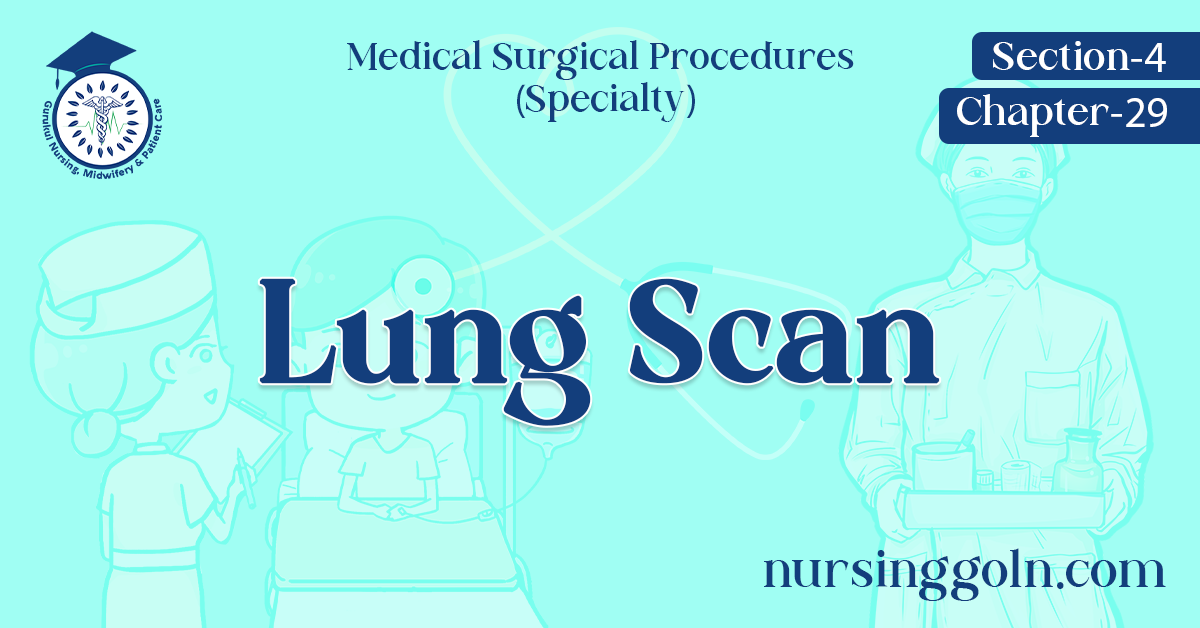Today our topic of discussion is Lung Scan.
Lung Scan

LUNG SCAN/PULMONARY SCINTIPHOTOGRAPHY
This nuclear medicine procedure is used to identify defects in blood perfusion of the lung in client’s with suspected pulmonary embolism. Blood flow to the lungs is evaluated using a macroaggregated albumin (MAA) tagged with technetium (Te), which is injected into the patient’s peripheral vein.
Because the diameter of the radionuclide aggregates larger that of the pulmonary capillaries, the aggregates become temporarily lodged in the pulmonary vasculature. A scintillator (gamma camera) detects the gamma rays from within the lung microvascular. With the use of light conversion, a realistic image of the lung is obtained on film.
The chest X-ray film aids in assessing the perfusion scan, because a defect on the perfusion scan seen in the same area as an abnormality on the chest X-ray film does not indicate pulmonary embolism.
Specificity of a perfusion scan also can be enhanced by performance of a ventilation scan, which detects parenchymal abnormalities in ventilation (e.g. pneumonia, pleural fluid, emphysematous bullae). The ventilation scan reflects the patency of the pulmonary airways, using krypton gas or Tc-diethylenetriamine- pentancetic acid (DTPA) as an aerosol.
When vascular obstruction (embolism) is present by perfusion, ventilation scan demonstrate a normal wash-out of radioactivity from the embolized lung area. If parenchymal disease (eg. pneumonia) is responsible for the perfusion abnormality, however, wash-in or wash-out will be abnormal.
Therefore, the mismatch of perfusion and ventilation findings is characteristic of embolic disorders, whereas the match is indicative of parenchymal disease. When ventilation and perfusion scan are performed synchronously, this is called a ventilation/perfusion (V/Q) scan.

Abnormal Finding
- Pulmonary embolism Pneumonia
- Tuberculosis
- Emphysema
- Tumor
- Asthma
- Atelectasis
- Bronchitis
- Chronic obstructive pulmonary disease.
Client Preparation
- Explain the procedure to the client
- Obtain informed consent if required by the institution
- Assure the client that he or she will not be exposed to large amounts of radioactivity, because only tracer doses of isotopes are used
- Inform the client that no fasting is required
- Recent chest X-ray should be available
- Instruct the client to remove jewelry around the chest area.
Procedure
The unsedated, nonfasting client suspected of having a pulmonary embolism is taken to the nuclear medicine department
Perfusions Scan
- The client is given a peripheral IV injection of radionuclide tagged MAA
- While client lies in the appropriate position, a gamma ray detector is passed over the client and records radionuclide uptake on Polaroid or X-ray film
- The client is placed in the supine, prone, and various lateral positions, which allows for anterior, posterior,
- lateral and oblique views, respectively The results are interpreted by a physician trained in diagnostic nuclear medicine.
Ventilation Scans
- The patient breathes the tracer through a face mask with a mouthpiece
- Less client cooperation is needed with a krypton tracer. Ventilation scans can be performed on comatose clients using krypton.
- Krypton images can be obtained before, during or after perfusion images
- In contrast, Tc-DTPA images are usually done before perfusion images and require client cooperation with deep breathing and appropriate use of breathing equipment to prevent contamination
- This test is usually performed by a physician in approximately 30 minutes
- Inform the client that no discomfort is associated with this test other than the peripheral venipuncture.
Post-procedural Care
- Apply pressure to the venipuncture site
- Inform the client that no radiation precautions are necessary.

Contraindication
Clients who are pregnant, unless the benefit outweigh the risks.
Interfering Factors
Pulmonary parenchymal problems (e.g. pneumonia, emphysema, pleural effusion, tumors) will give the picture of a perfusion defect and stimulate pulmonary embolism.
Read more:
